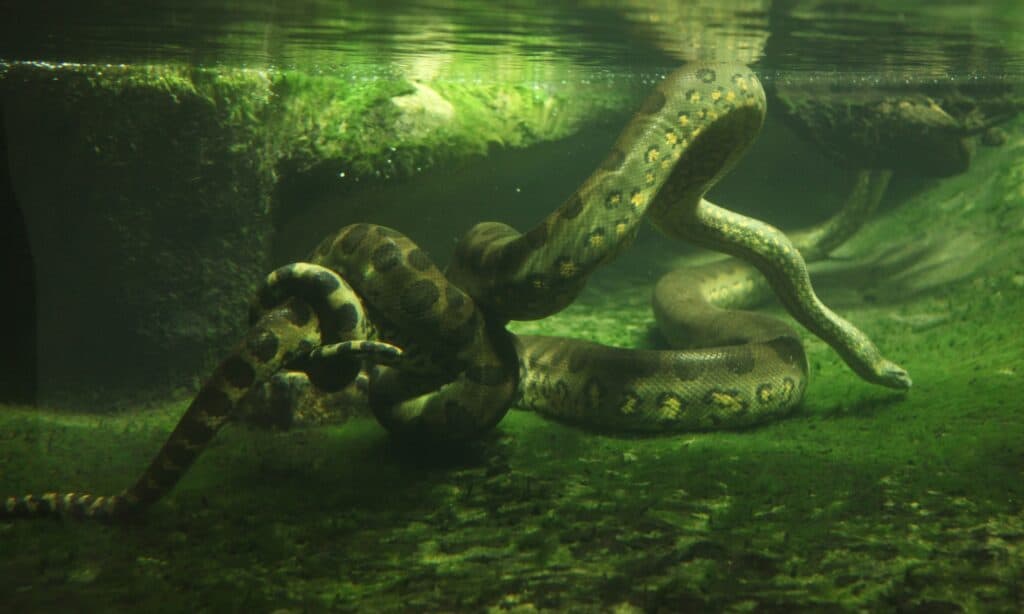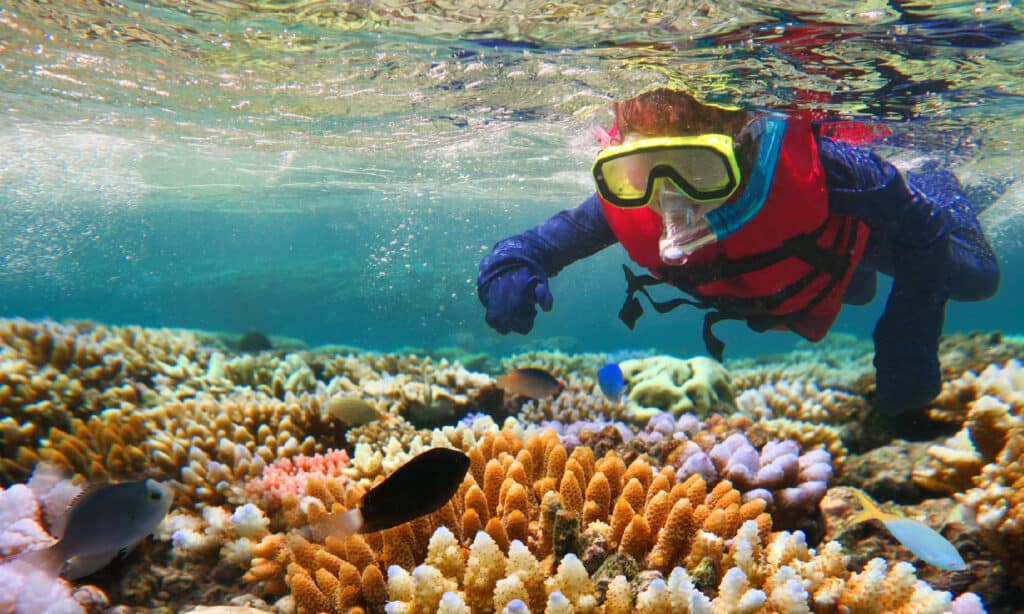Australia is located in the Pacific Ocean. It’s the smallest continent but one of the largest countries and home to many species of animal. However, not all of these animals are still with us. Here are 8 extinct Australian animals from prehistoric snakes to a small rodent that was only classified as extinct a few years ago.
1. Bluff Downs Giant Python (Liasis dubudingala)

Bluff Downs Giant Python was a meter longer than the South American Anaconda
©Vladimir Wrangel/Shutterstock.com
This massive python is one of the most terrifying extinct Australian animals. It was thought to measure ten meters long, that’s at least another meter on top of the South American Anaconda or the Reticulated Asian Python.
It hunted birds, reptiles and mammals in vine thickets near water. Palaeontologists found their fossilized remains at Bluff Downs in Northern Queensland in 1992 and have concluded it was Australia’s largest ever snake. Luckily for its prey, the Bluff Downs giant python went extinct 4 million years ago in the early Pliocene era.
Its closest living relative is the olive python (Liasis oliacea), but it’s nowhere near as big. Olive pythons only reach 3.5-5 meters, not even halfway there!
2. Tasmanian Tiger (Thylacinus)

The last Tasmanian tiger died in captivity in 1936
©Adwo/Shutterstock.com
The Australian Tasmanian tiger was a carnivorous marsupial and the only member of the Thylacinidae family to survive to recent times.
Tasmanian tigers looked much like dogs. They had sandy brown-grey fur with up to 20 dark tiger-like stripes hence the name Tasmanian tiger. Unlike a tiger, they had dog-like heads with powerful jaws and the females carried their young in a back-opening pouch.
These amazing marsupials were hunted to extinction by settlers in the 1800s for their skin and because they preyed on settlers’ farm animals. Their native prey were kangaroos, small mammals, and birds.
The very last Tasmanian tiger died in 1936 in Hobart Zoo, but not all is not lost. People claim to have seen them in the wild even though an official sighting hasn’t been seen for at least 70 years. This article in Plos One discusses the possibility of any Tasmanian tigers still in existence.
3. Christmas Island Skink (Emoia nativitatis)
The Christmas Island skink was a small lizard endemic to Christmas Island. The very last one named Gump died in captivity in 2014. This heralds the first extinction of an Australian lizard for the extinct Australian animal list.
These little skinks were about 20 cm long, quite chunky, and usually a rich chocolate brown color. They lived in leaf litter in forest clearings and spent much of their time on the ground.
They were abundant on Christmas Island when first discovered in 1887 and were still there in 1979, however, the number plunged during the 1990s and by 2003 98% were gone.
Herpetologists still don’t know what happened but think predation from introduced species such as cats, wolf snakes, giant centipedes, and yellow crazy ants alongside insecticide poisoning contributed to their extinction.
4. Christmas Island Pipistrelle (Pipistrellus murrayi)
Another recent Christmas Island extinction is the pipistrelle bat. It was last seen in August 2009 and although officials have undertaken intensive surveys, one hasn’t been located since.
The Christmas Island pipistrelle was a vesper bat endemic to Christmas Island and the smallest species in Australia. It only weighed 0.11-0.16 grams and was a tiny 1.2 inches in length. This little pipistrelle fed on insects and nested in hollow trees.
Once commonly seen, its numbers plummeted in the 1990s alongside the Christmas Island Skink. No one knows why, but again it may have been predated upon by cats, wolf snakes, giant centipedes, and yellow crazy ants that were introduced to the area. Insecticide poisoning is another popular theory. The Christmas Island pipistrelle fed on insects so it’s entirely possible.
5. White-Footed Rabbit-Rat (Conilurus albipes)
This extinct species of rodent was originally found in the Adelaide to Sydney woodlands. It made nests from leaves inside hollow eucalyptus trees.
Around kitten-sized at 23-26 cm in length and weighing 7.5 ounces (200 grams) this rodent was Australia’s largest and caused havoc in settlers’ grain stores in the 1780s. It resembled a squirrel with a bi-colored bushy tail that was dark brown but white underneath.
The very last one was recorded in 1845 with possible sightings in the 1930s. It’s thought that settlers cats, red foxes and rats contributed to their extinction alongside widespread deforestation for farmland.
6. Bramble Cay Melomys (Melomys rubicola)

Bramble Cay melomys lived near the Great Barrier Reef but rising
ocean
levels destroyed their habitat
©iStock.com/chameleonseye
Only recently announced as extinct in 2016 this little brown rodent was part of the family Muridae and subfamily Murinae. It’s the first known mammal extinction caused by human-induced climate change.
Melomys rubicola was endemic to Bramble Cay, a vegetated coral cay in the Great Barrier Reef near Papua New Guinea in the Torres Strait. Time ran out when on multiple occasions rising ocean levels due to global warming inundated the low-lying cay, drowning them and destroying their habitats.
Before its extinction, this was a fairly large rodent measuring 5-6.5 inches with a tail of 5 -7.25 inches. It had reddish brown fur on top and grey fur beneath plus black guard hairs on it back. Its food included herbs and bird eggs.
7. White Swamphen (Porphyrio albus)
The list of extinct Australian animals includes birds. The white swamphen was a species of rail that lived on Lord Howe Island and was considered endemic.
It was around 14-22 inches long with mainly white plumage. According to accounts taken between 1788 and 1790, the chicks hatched black, became blue, and finally white as they matured! The white swamphen had red legs and was not a good flier, if it flew at all.
Although it was endemic to Lord Howe Island its closest living relative is the Australasian swamphen. A skin is displayed in the Natural History Museum of Vienna.
It was hunted to extinction in 1834 before the island was inhabited by visiting sailors over 40-50 years.
8. Gastric Brooding Frogs (Rheobatrachus)
Southern and northern gastric-brooding frogs are better known as platypus frogs. They were native to Queensland in eastern Australia but became extinct in the 1980s.
They’re named after their habit of gestating young in the mother’s stomach. Only one other known frog species does so.
They had a small habitat of around 770 square miles and lived in rainforest areas and creek systems that rarely dried up. They ate caddisfly larvae, aquatic beetles, and other small frogs. The northern species was larger, but both types of frog were brown with yellow undersides. Of the two, the southern type was slightly lighter in color.
Once numerous, both gastric brooding frog species haven’t been seen in the 1980s. Searches have found nothing to indicate they still exist.
The exact reasons for their extinction aren’t known but experts suggest habitat loss, creek pollution, and disease were responsible.
Summary
Australia was recently identified as the fourth worst country for animal extinctions, but the government and scientists are trying to rectify that with conservation measures and breeding programs.
Let’s hope they manage to reverse the fortunes of endangered Australian animals, such as the iconic koala listed as endangered in 2022 on the East coast, before it’s too late.
The photo featured at the top of this post is © Benjamin A. Sheppard / public domain – License / Original
Thank you for reading! Have some feedback for us? Contact the AZ Animals editorial team.






